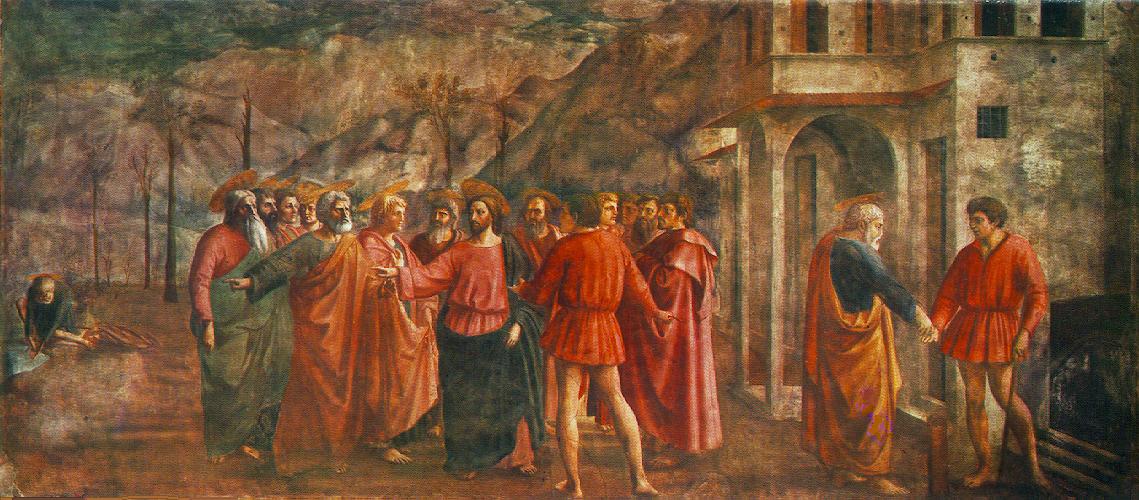 Tribute Money by Massaccio
Tribute Money by MassaccioFirst, I want to address perspective. It’s very hard for many people to grasp the idea of perspective. If you’re ever taken that dreaded drawing class, you know how troublesome it can be to grasp the concept of one and two point perspective (boxes on a horizon line sound familiar?). Remember the Arena Chapel from chapter 19? Giotto made a brave attempt to introduce to the late Gothic period the use of perspective. Comparatively, Giotto is dabbling in perspective where as Masaccio mastered it. True, there’s been over 200 years of opportunity for perfection. But Masaccio “gets it!” Giotto’s figures seem to be placed “on” the fresco, where as Masaccio’s figures are part of the landscape and as such achieve that 3rd dimension. Masaccio introduced atmospheric perspective, something Giotto didn’t show us in the frescos he painted in the chapel. The innovation of this type of perspective adds to the 3-D quality of an image; rounding out the flatness of 2-D representation.
Also, like Giotto, Masaccio employs chiroscuro, but with Masaccio, light has a nature of its own; Giotto forces light into his scenes. In Tribute Money, the light source is outside of the picture and is represented in a more natural way. Masaccio works his magic with light.
Both artists depict their figures with bright colors emphasizing the importance of the narrative and the participants.
As I understand Masaccio was to be a very important influence on Michelangelo…I’m looking forward to discussing The Doni Tondo to see this connection in action.
http://employees.oneonta.edu/farberas/arth/Arth213/arenachapel.html
http://www.wfu.edu/~liebsg5/FYS100/masaccio.htm
Ahhh Sandro Botticelli…The Birth of Venus.
He threw out all the progress made with perspective and mathematical harmonies, and reintroduced a flat, 2D background and yet delivered a visual masterpiece. Like our text says, “Botticelli created a style of visual poetry … his paintings possess a lyricism and courtliness…”
Gone is the heaviness of religiosity. Here we see the re-introduction of the female nude. Surely Boticelli read and studied Praxiteles and his Aphrodite of Knidos. Like Praxiteles, Boticelli’s Venus has soft radiant flesh, dewy eye and a fleshy, womanly figure; not an overt sexual representation but a depiction of divinity. God’s perfection in human form.

http://penelope।uchicago.edu/~grout/encyclopaedia_romana/greece/hetairai/aphrodite.html
No comments:
Post a Comment